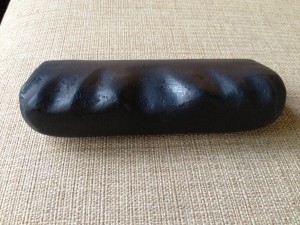Six months ago I wrote about the virtues of using an iPad Mini tablet in the patient care setting. At that time I was using my tablet almost all day, every day for multiple purposes including EMR data capture. Things went well for a while, but as time passed I used the tablet less and less. Eventually I stopped using it almost altogether except for displaying and annotating CT images during patient visits. At first I did not understand why. Was the non-Retina display finally getting to my 50+ year old eyes? Was the external microphone I used to improve speech recognition losing performance? Was the battery fading after 9 months of charge / discharge cycles? Or was the “gadget lust” of a new tech-toy finally wearing off?
Each of the above may be just a little bit true. But two other reasons are most relevant to me. First, my efforts to add a medical vocabulary to the embedded speech recognition failed. But most importantly, I became frustrated with how difficult the tablet was to hold for extended periods of time. When I wrote that the tablet was “easily and comfortably held by its edge” I was wrong. Tablets are beautiful to behold, but their clean lines and smooth surfaces make holding them for extended periods of time very cumbersome.
So I created something that would fix the problem by making a tablet more comfortable and safe to hold. Now that the provisional patent application is registered I can share the design:
The photos are of a nonfunctional mockup I made out of Styrofoam, balsa wood and spackling compound. It is a grip that attaches primarily to one edge of a tablet computer and facilitates holding the tablet by its edge rather than the back. It is shaped to fit the hand and allows both proper hand positioning and proper viewing angle. It provides a mechanical interface between the tablet edge and a semi-pronated (handshake position) hand/forearm. Its purpose is to facilitate extended use of the tablet by minimizing orthopedic strain to the hand, wrist, forearm, elbow, shoulders and neck. The interface with the remaining 3 edges is minimal, preserving the ability to store the tablet-grip assembly in a coat pocket.
The external shell is a composite of plastic, rubber, metal, leather or similar materials. There may also be a thin covering over the back and/or front faces of the tablet for protection and mechanical stability. The top side is contoured to engage the thumb and guide the thumb to the home button. The bottom is contoured to engage the fingers. This shape gives the thumb and fingers stability and purchase to counter the tablet’s weight and torque in the yaw and roll axes. The gripped portion has bilateral symmetry to allow left hand or right hand grip. Openings and mechanical and/or electronic pass-throughs provide access to tablet buttons, ports, etc. It could also include a stand for self-support on a tabletop and a place to store a stylus. Some panels could be customized for color, shape (i.e., for different hand sizes) or material.
There is space available within the grip to add hardware and enhance functionality. Examples include – but are not limited to – extended battery, external microphone / speaker, Bluetooth keyboard interface (to make the composite device appear as a keyboard to an external workstation), wireless USB, and apps that use cloud-based speech to text capability. Any companion software component – an app – would be loaded into the tablet itself.
I need your help both to estimate the potential of this idea and get some advice on what to do with it next. If you think this is an idea worth pursuing give me a like on Facebook at the bottom of the article. If you feel strongly about it give it a Tweet as well. And if you have some advice I would be grateful to hear it.
















I definitely would like or participate in evaluating the potential of your concept.
As our dental web application relies on tablets mobility and flexibility, it could be quite interesting for us to improve the user experience outside our product.
Cedrik Caron
Marketing Director
Dovetail.co